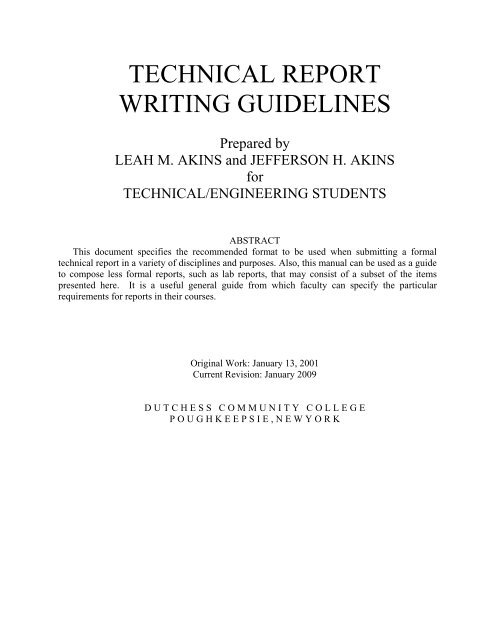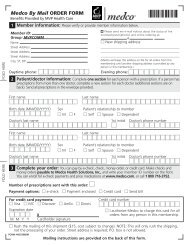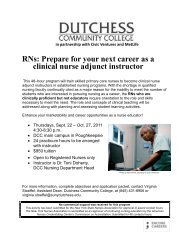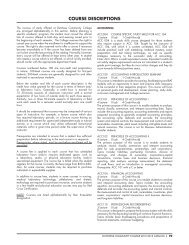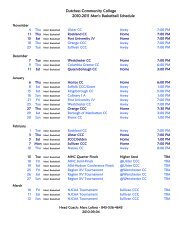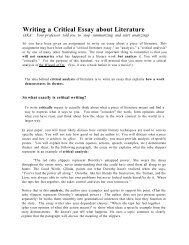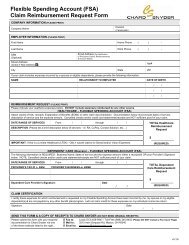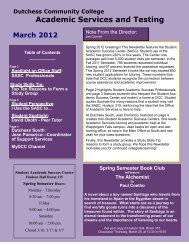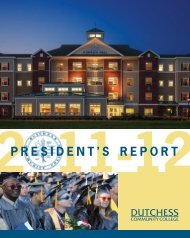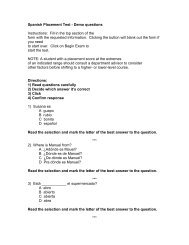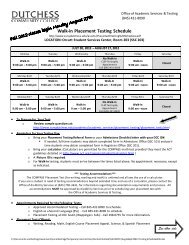TECHNICAL REPORT WRITING GUIDELINES
TECHNICAL REPORT WRITING GUIDELINES
TECHNICAL REPORT WRITING GUIDELINES
Create successful ePaper yourself
Turn your PDF publications into a flip-book with our unique Google optimized e-Paper software.
<strong>TECHNICAL</strong> <strong>REPORT</strong><strong>WRITING</strong> <strong>GUIDELINES</strong>Prepared byLEAH M. AKINS and JEFFERSON H. AKINSfor<strong>TECHNICAL</strong>/ENGINEERING STUDENTSABSTRACTThis document specifies the recommended format to be used when submitting a formaltechnical report in a variety of disciplines and purposes. Also, this manual can be used as a guideto compose less formal reports, such as lab reports, that may consist of a subset of the itemspresented here. It is a useful general guide from which faculty can specify the particularrequirements for reports in their courses.Original Work: January 13, 2001Current Revision: January 2009D U T C H E S S C O M M U N I T Y C O L L E G EP O U G H K E E P S I E , N E W Y O R K
Table of ContentsINTRODUCTION ...................................................................................................................................... 1THE FORMAL <strong>TECHNICAL</strong> <strong>REPORT</strong> .......................................................................................................... 1UNIVERSAL ASPECTS OF ALL <strong>REPORT</strong>S ............................................................................................... 1<strong>REPORT</strong> FORMAT ................................................................................................................................ 2TITLE PAGE ...................................................................................................................................... 2ABSTRACT ....................................................................................................................................... 2TABLE OF CONTENTS ...................................................................................................................... 2INTRODUCTION .............................................................................................................................. 2BACKGROUND THEORY .................................................................................................................. 3DESIGN / THEORETICAL ANALYSIS .................................................................................................. 3PROCEDURE .................................................................................................................................... 3RESULTS AND DISCUSSION ............................................................................................................. 5CONCLUSION .................................................................................................................................. 5WORKS CITED ................................................................................................................................. 6APPENDIX ....................................................................................................................................... 6HOW A READER IN INDUSTRY PERUSES A <strong>TECHNICAL</strong> <strong>REPORT</strong> AND WHY YOU SHOULD KNOW .......... 6CONCLUSION .......................................................................................................................................... 6WORKS CITED ......................................................................................................................................... 7Appendix A – Creating Works Cited Page and Citations within Report ................................................. 8Citing an Article in a Periodical [1] ..................................................................................................... 8Citing a Book [1] ................................................................................................................................. 8Citing Full Text Databases Using APA Format [2] ............................................................................... 8Citing World Wide Web Documents [2] ............................................................................................. 9Creating Parenthetical Citations Using APA Format [3] ..................................................................... 9Appendix B – Writing Tips for Results and Discussion Section ............................................................ 10Percent Difference/Error .................................................................................................................. 10Magnitude of Error ........................................................................................................................... 10Writing Discussion Based on Lab Questions..................................................................................... 10Guidelines for Graphs ....................................................................................................................... 11APPENDIX C – <strong>GUIDELINES</strong> FOR ANSWERING <strong>TECHNICAL</strong> QUESTIONS ............................................... 12
INTRODUCTIONThe purpose of a technical report is to completely and clearly describe technical work, why it was done,results obtained and implications of those results. The technical report serves as a means ofcommunicating the work to others and possibly providing useful information about that work at somelater date. A well‐written report allows the reader to quickly understand what has been accomplished.The report also provides sufficient detail to allow the reader to recreate the results although the level ofdetail provided depends heavily on the report’s audience and any proprietary nature of the work.Clear presentation of results is at least as important as the results themselves; therefore, writing areport is an exercise in effective communication of technical information. Results, such as numericalvalues, designed systems or graphs by themselves are not very useful. To be meaningful to others,results must be supported by a written explanation describing how results were obtained and whatsignificance they hold, or how a designed system actually functions. Although the person reading thereport may have a technical background, the author should assume unfamiliarity with related theoryand procedures. The author must therefore supply details that may appear obvious or unnecessary.With practice, the technical report writer learns which details to include.The key to a well‐written report is organization. A report that is divided into several sections, occurringin a logical sequence, makes it easy for the reader to quickly obtain an overview of the contents as wellas locate specific information. This document provides guidelines for producing a well‐written technicalreport.THE FORMAL <strong>TECHNICAL</strong> <strong>REPORT</strong>The formal technical report contains a complete, concise, and well‐organized description of the workperformed and the results obtained. Any given report may contain all of the sections described hereinor a subset, depending upon the report requirements. These requirements are decided by the authorand are based on the audience and expected use of the report.All reports have certain aspects in common regardless of expected usage. Common report sections arepresented first, and all possible sections potentially included in a report are discussed afterwards.UNIVERSAL ASPECTS OF ALL <strong>REPORT</strong>S• The report should be written in an active voice using the third person in most instances. Avoid usingpersonal pronouns. Personal pronouns tend to personalize the technical information that isgenerally objective rather than subjective in nature. Use correct grammar, punctuation, and spelling.Attention to these details results in a professional tone to the report.• All diagrams must be neatly presented and should be computer generated. Use a computersoftware package, such as Paint, Multisim or AutoCAD, to draw diagrams. Leave at least a one‐inchmargin on all sides of a full page diagram and always number and title all figures. Always insert afull‐page diagram or graph so it can be read from the bottom or from the right side of the page.• All pages of the report after the Table of Contents must include the page number.• Any information in the report that is directly quoted or copied from a source must be cited using theproper notation [1, 2, 3].1
• Any information in the report that is directly derived or paraphrased from a source must be citedusing the proper notation [1, 2, 3].• Any reference material derived from the web must come from credible and documentable sources.Students need to evaluate websites critically. The first step is to verify a credible author.• Wikipedia is NOT a credible reference because the information changes over time and authors arenot necessarily people with verifiable expertise or credentials.• For all paper reports, all pages of the report must be 8 ½“ X 11” in size. Any larger pages must befolded so as to fit these dimensions.<strong>REPORT</strong> FORMATThe pages of the report are to be assembled in the following order. This is the recommended order,however, certain reports may lend themselves to either reordering sections and/or excluding sections.TITLE PAGEThe format for this page may vary, however, the following information is always included: report title,who the report was prepared for, who the report was prepared by, and the date of submission. This isnot a numbered page of the report.ABSTRACTAn abstract is a concise description of the report including its purpose and most important results. Anabstract must not be longer than half a page and must not contain figures or make reference to them.The results may be summarized in the abstract but qualitatively, not quantitatively. No specific technicaljargon, abbreviations, or acronyms should be used. This is not a numbered page of the report.TABLE OF CONTENTSInclude all the report sections, subsections, and appendices. This is not a numbered page of the report.INTRODUCTIONGive the objective of the work, a brief description of the problem, and how it is to be attacked. Thissection should provide the reader with an overview of why the work was performed, how the work wasperformed, and the most interesting results. This can usually be accomplished with ease if the work hasclearly stated objectives. After introducing the problem, indicate how those objectives are met. Thelength of this section depends on the purpose but the author should strive for brevity, clarity, andinterest.Be careful not to use specific technical jargon or abbreviations such as using the term “oscope” insteadof “oscilloscope” . Also, make sure to define any acronyms or abbreviations prior to using them. Forexample, in a surveying lab report a student might want to refer to the electronic distance measuring(EDM) device. The first time the device is referred to, the student must spell out what the acronymstands for before using the acronym as demonstrated in the previous sentence. This practice should beapplied throughout the report when the author wants to use an acronym that has not yet been definedwithin the report. Do not assume that the reader is familiar with all the acronyms that are familiar tothe author.2
BACKGROUND THEORYInclude, if necessary, a discussion of relevant background theory. For example, if the phase shift of an RCcircuit is to be measured, give the derivation of the theoretical phase shift. Include any preparationspecified in the lab manual. In deciding what should or not should be included as background theory,consider presenting any material specific to the lab that you had to learn prior to performing the lab.This section may be divided into subsections if appropriate. Keep the discussion brief and refer thereader to outside sources of information where appropriate. The proper method of providingreferences and making citations within the report is provided in Appendix A.DESIGN / THEORETICAL ANALYSISGive the details of your design procedure. Be sure to introduce and describe your design work usingsentences, equations alone are not sufficient. Use citations if you wish to refer the reader to referencematerial. Divide this section into subsections where appropriate. For example, a lab design may consistof designing several circuits that are subsequently interconnected; you may choose to treat each circuitdesign in its own subsection. Keep this section as general as possible, only applying specific numbersafter the design is explained.If there is no design but strictly analysis, then provide the important details of all the analysis performed.Be brief. It is not necessary to show every step; sentences can be used to describe the intermediatesteps. Furthermore, if there are many steps to the analysis, the reader should be directed to theappendix for complete details.PROCEDUREThis section varies depending on requirements of the one who assigned the work and the audience. Ata minimum, the author discusses the procedure by describing the method used to test a theory, verify adesign or conduct a process. Presentation of the procedure may vary significantly for different fieldsand different audiences, however, for all fields, the author should BE BRIEF and get to the point. Likewith any written work, if it is unnecessarily wordy, the reader becomes bored and the author no longerhas an audience. Also, the procedure section should never include specific measurements/results,discussion of results, or explanation of possible error sources. Make sure all diagrams provided arenumbered, titled, and clearly labeled.Depending on the situation, there are two likely types of procedure sections. In one case, a detailedprocedure may have already been supplied or perhaps it is not desirable to provide a detaileddescription due to proprietary work. In another case, it might be the author’s job to provide all thedetail so the work can be duplicated. The latter is more common in academic lab settings. The writingguidelines for each of these possible procedure sections are provided below.Procedure Type 1Use this procedure type if you have been supplied with a detailed procedure describing the stepsrequired to complete the work.• If required by the person who assigned the work, include the detailed procedure in theappendix.• Briefly describe the method employed to complete the work. This is meant to be a briefdescription capturing the intention of the work, not the details. The reader must be referred tothe appendix for the details. DO NOT refer to procedure steps.3
• If the work required a lab set‐up, provide a diagram of that set‐up (i.e. circuit diagram).• Provide additional diagrams and/or pictures if it will assist the reader in understanding thedescription.• Provide a detailed procedure of any work performed for which detailed steps were notprovided.• Examples:o Acceptable writing:• In order to test the theory of superposition, the circuit shown in Figure 1 isemployed. The circuit is constructed on the lab bench and using Multism TM , acircuit simulation software. In both settings, a multimeter is used to measurethe output voltage, as shown in Figure 1, for the following three cases: (1)Source 1 on and Source 2 off, (2) Source 1 off and Source 2 on, and (3) bothsources on. These measurements are compared to the output voltage derivedusing theory as described earlier. Refer to the appendix for detailed steps tocomplete this work.o Unacceptable writing:• In order to test the theory of superposition, first each team member mustcalculate the output voltage for the circuit shown in Figure 1 for the followingthree cases: (1) Source 1 on and Source 2 off, (2) Source 1 off and Source 2 on,and (3) both sources on. Then one team member is assigned to build the circuiton the lab bench while the other team member constructs the circuit inMultisim. Once constructed, turn Source 1 on and Source 2 off then connectthe positive lead of the meter to the positive end of the output voltage and thenegative lead of the meter to the negative end of the output voltage. Recordthe meter reading. Next turn on Source 2 and turn off Source 1. Again measurethe output voltage using the meter ….Procedure Type 2Use this procedure type if you have not been supplied with a detailed description of the steps requiredto complete the work.• Describe in detail all necessary steps or processes required to complete the work. This mayinclude, but is not limited to, the following:o Equipment useo Equipment maintenanceo Define terms specific to the technologyo Measurement techniques and/or calibration• The description, as detailed above, should be sufficiently clear so that the reader could duplicatethe work.• Do not assume that the reader has prior knowledge or access to prior reports, textbooks, orhandouts.• If part of the procedure was successfully described in a previous report, either repeat theprocedure or include that report in the appendix and refer the reader to it.• Where appropriate, provide diagrams and/or pictures to assist the reader in understanding theprocedure.4
RESULTS AND DISCUSSIONPresent the results of the work performed using neatly organized and completely labeled tables and/orgraphs whenever possible. When comparative data is available, present the data in a way that facilitatesthe comparison. For example, if theoretical and experimental values are available, present the valuesalongside one another accompanied by percent error. If it would help the reader understand theresults, include a few sample calculations but put lengthy calculations in an appendix.ALWAYS accompany results with a meaningful discussion. The discussion explains what the results meanand points out trends. In some cases, the results speak mostly for themselves and the discussion may bebrief, i.e., “Table 2 shows that the designed variable modulus counter works as expected”. In othercases, the meaning of the results may not be as clear requiring more detailed discussion.ALWAYS discuss the possible sources of error and how accurate the results need to be in order to bemeaningful. Do not include a discussion of possible sources of error that would not add significantly tothe observed error. What counts as significant depends on the situation. For example, if thecomponents used have a tolerance of 5% and the accuracy of the equipment is within 0.1% of themeasured value, then the equipment does not add any significant error. In general, it is impossible toobtain error‐free results, however, attention to detail when conducting procedures should minimize theerror. Errors are different from mistakes. It is unacceptable to report mistakes. If a mistake was madein the work, the work must be repeated until acceptable tolerances are achieved before submitting areport.When working in the industry, it is imperative to know how accurate the results need to be. It is worthyour time and effort (and in the best interest of your boss or client) to provide the appropriate level ofaccuracy. If that means repetitive measurements to check for accuracy within tolerance, then do it. If itmeans performing a detailed analysis prior to making measurements, then do it. In the academicsetting, the result of laziness or lack of effort may only be a bad grade. In the workplace, you may getfired!Other information pertaining to writing the Results and Discussion section can be found in Appendix B.This information includes• How to calculate percent difference/error.• Typical magnitudes of percent error for courses where circuits are constructed.• What to consider writing about based on lab questions.• Guidelines for graphs provided in a report.CONCLUSIONIn this final section of the body of the report, the author should briefly bring everything together. It issimilar to the abstract except that now the results are concluded upon in a quantitative way. Therefore,the conclusion should be a concise description of the report including its purpose and most importantresults providing specific quantitative information. The conclusion should not contain figures or makereference to them. As with the abstract, the reader should be able to read this section on its own whichmeans that there should be no specific technical jargon, abbreviations, or acronyms used.5
WORKS CITEDList all works cited in the report, include all the important bibliographical information. The Works Citedshould begin on a new page, not on the same page with the conclusion. Refer to Appendix A forinformation on preparing the Works Cited section.APPENDIXThis section may not always be present. Materials included in an appendix may include lab sheets, partslist, diagrams, extensive calculations, error analyses, and lengthy computer programs. Introducenumbered appendices rather than putting different items in one appendix.HOW A READER IN INDUSTRY PERUSES A <strong>TECHNICAL</strong> <strong>REPORT</strong> AND WHY YOUSHOULD KNOWFor obvious reasons, the reader will first read the title page and abstract. Therefore, it is imperative thatthe abstract be clear and well written. It should tease the reader into looking further into the paper. Theconclusion is often the next section to be read. All valuable readers, politically speaking, will jumpdirectly to the conclusion making it important to provide a table of contents to ease documentnavigation. If the conclusion, relative to the title page, sounds interesting and conclusive they will readthe other sections to learn more.The introduction is read next. It should provide the reader with enough information about how thereport progresses so that the reader can pick and choose which sections are most applicable to theirinterests. Based on this, some or all of the subsequent sections may be read.In light of understanding how a technical report is read, there are several general guidelines to consider:• A professional looking and well‐organized document sets the tone for the reader.• If you use acronyms, describe them first then include the acronym in parenthesis, i.e. DigitalMultimeter (DMM). Do not use acronyms in the abstract and conclusion sections.• DO NOT be judgmental in your writing; “I felt that …”, “the results were great …”, etc. Presentthe work clearly and validate the work with data accompanied by meaningful discussion.• Give your report to someone to proofread. Note where they had questions or couldn’tunderstand your discussion. Then see if you can improve how that information is presented.• Remember that the reader can’t understand what you are “thinking”. Write your report for atechnical peer but do not assume they are comfortable with the current course material.• Write your reports independent of other reports. Referring to a “Lab 3 Part 1” does not meananything to a general audience.CONCLUSIONTechnical Report Writing Guidelines provides a recipe for writing technical reports for a variety ofdisciplines and applications. If all of the information contained herein is studied and applied, the resultwill be a report worth reading. Considering that most technical jobs require accurate communicationthrough written material, developing good technical writing skills can only improve your career status.Be aware that most jobs in a technical field require a significant amount of technical writing, frominformal memos to formal proposals for presentation to customers. It is worth your time to read thismaterial carefully and practice your writing skills.6
WORKS CITED[1] Citing Full Text and World Wide Web Documents Using APA Format . (n.d.). Retrieved December 21,2008 from http://libraryreference.sunydutchess.edu/citations.htm.[2] Citing Printed Resources Using APA Format. (n.d.). Retrieved December 21, 2008 fromhttp://libraryreference.sunydutchess.edu/citations.htm.[3] Creating Parenthetical Citations and Reference List Pages Using APA Format. (n.d.). RetrievedDecember 21, 2008 from http://libraryreference.sunydutchess.edu/citations.htm.7
Appendix A – Creating Works Cited Page and Citations within ReportA tremendous amount of information on proper citing of references in reports as well as how to cite thereference within the body of a report is provided by the College’s Library (see website athttp://libraryreference.sunydutchess.edu/citations.htm). For technical reports, the AmericanPsychological Association (APA) method or a modified version as explained below is most often used.For your convenience, this information is provided here, however, it is worth reviewing the websitebecause other valuable resources are provided that facilitate bibliography creation.For technical reports, a modified APA method is often used. Using the APA method, a reference is citedin the body of the report using a “parenthetical citation”. Within the parenthesis, a lot of information issupplied including the author, the publication date, and the page number. If no author is provided, thenthe title of the referenced work is included. With this technique, a parenthetical citation referencing theinformation cited here would be (Creating Parenthetical Citations and Reference List Pages Using APAFormat, 2008). In technical reports, an abbreviated method is often used where the reference isidentified by the numbered list in the Works Cited section. Using this abbreviated notation, thereference would be just [3]. Square brackets must be used.After the conclusion of a report, if outside sources of information were used a numbered list of thereferences is provided in the order cited within the paper. Examples of bibliographic information forperiodicals and books can be found in [1] and for full text electronic databases and web sites in [2]. Thedetails of how a citation should be written are copied from [1] and [2] here for your convenience. Alsoprovided here is the classic method of providing a parenthetical citation using the APA method [3] incase you opt for that technique rather than the modified method described above.Citing an Article in a Periodical [1]When citing an article in a periodical, you must include:• The author(s) last name(s), followed by a comma, and first initial (s), followed by a period.• The year of publication and date, in parentheses, followed by a period.• The article title followed by a period. Capitalize only the first word and any proper nouns (names,places, etc).• The title of journal, in italics, followed by a comma.• The volume number in italics.• The issue number (if available) in parenthesis, followed by comma.• The pages followed by a period.Citing a Book [1]When citing a book, you must include:• The author(s) last name(s), followed by a comma and first initial (s), followed by a period.• The year the book was copyrighted in parentheses, followed by a period.• The title of the book, in italics and followed by a period. Capitalize only the first word and anyproper nouns (names, places, etc).• The place of publication, followed by a colon.• The publisher followed by a period.Citing Full Text Databases Using APA Format [2]When citing an article from a full text database, you must include:• The author(s) last name(s) first, followed by a comma, and first initial, followed by a period.8
• The year of publication in parentheses and date, followed by a period.• The article title followed by a period. Capitalize only the first word and any proper nouns (names,places, etc).• Title of the journal, in italics, followed by a comma.• The volume number (if available) in italics.• The issue number (if available) in parenthesis, followed by a comma.• The pages followed by a period.• The phrase “Retrieved” followed by the date you accessed the article followed by a comma.• The word “from” and the name of the database followed by a period.Citing World Wide Web Documents [2]When citing information that was retrieved from a website, you must include:• The author(s) last name(s) (if available) followed a comma and first initial.• The year of publication (if available) in parentheses. If no date is available, use (n.d.)• The title of the document in italics followed by a period. Capitalize only the first word and anyproper nouns (names, places, etc).• The phrase “Retrieved” followed by the date you found the document on the Web followed bythe word “from” and a comma.• If a government or academic site, the name of the host organization followed by a colon.• The Web address (URL), followed by a period.Creating Parenthetical Citations Using APA Format [3]Parenthetical citations are used to identify the sources you used in writing your paper. These citationsappear in an abbreviated form within the text of your paper and lead a reader to the full citations inyour Works Cited Page. The standard rule for parenthetical text citations is to include:• An open parenthesis (• The author’s last name, if available and not named in the text, followed by a comma• If no author, the title, in quotation marks• The date the source was published, if available, followed by a comma• The page number(s), for direct quotes or if needed to uniquely identify the source, proceeded by“p.” or “pp”. For electronic sources, use ”para” to identify a quote from a specific paragraph• A close parenthesis )9
Appendix B – Writing Tips for Results and Discussion SectionThis information includes:• How to calculate percent difference/error.• Typical magnitudes of percent error for courses where circuits are constructed.• What to consider writing about based on lab questions.• Guidelines for graphs provided in a report.Percent Difference/ErrorAlways calculate meaningful percent difference where percent difference is commonly understood tobe:% difference = {(measured value – theoretical value ) / (theoretical value )} X 100%The measured value is the same as the experimental value. This value is determined throughexperimentation. The theoretical value is determined from an analysis and does not depend on anymeasured value.Magnitude of ErrorYou must provide reasoned discussion whenever a significant percent error exists. What is consideredsignificant depends on the work undertaken and the associated accuracy requirements. The degree ofaccuracy is generally limited by a factor(s) likely beyond control of the experimenter.For example, standard resistors have a tolerance of 5%. Therefore, a percent difference less than 5%can be attributed to the resistor tolerance. Other error sources are likely insignificantly smallcomparatively. Capacitors may have a tolerance of 10%. In circuits with capacitors, error up to 10%may be attributed to component tolerance.If the percent difference determined is greater than the component tolerance, then one of threepossible reasons should be considered. First, the percent difference could be an indication that thetheory is not predicting the results as generally expected. In this case, there must be a reason to suspectflawed theory and it is important to determine any theoretical assumption(s) at fault. Second, anothererror source may exist that can not be mitigated is at fault. In this case, the error source must beidentified and explained. Third, a significant (and unacceptable) human error was made duringexperimentation in which case the experiment needs to be redone. Generally, a percent differencegreater than 15% indicates a gross error in the lab which must be identified WHILE in lab. Recognizingthat lab preparation always includes performing theoretical predictions first and may also includecomputer simulation, the experimenter MUST be in a position to judge the data as it is being recorded.If a large percent difference is noted during lab, do not proceed until the problem is resolved. This mayinclude seeking assistance from the instructor and obtaining permission to proceed.Writing Discussion Based on Lab QuestionsWhen writing the results and discussion section, pay close attention to all questions posed by theinstructor. Generally, lab questions indicate aspects of the lab considered most important and must bediscussed along with the presentation of results.10
Guidelines for GraphsAlways refer to graphs and tables when discussing results. Construct graphs using the followingguidelines:1. Create the graph using a computer software package such as Microsoft Excel. If computeraccess is not available, use grid paper.2. Provide one‐inch margins on all sides; do not write in the margins.3. Clearly label axes, including quantity plotted and its units.4. Use a smoothed line to produce the best‐fit curve.5. Clearly indicate data points using a circle, triangle, or square. Use different shapes for differentcurves plotted on the same axes.6. Label different curves plotted on the same axes.7. Number and title every graph. “Figure 1: V vs. R” is NOT an acceptable title whereas “Figure 1:Measurement of Voltage (V) as a Function of Varying Resistance (R)” is.8. Place all graphs in the report so that the bottom of the graph is either along the bottom of thepaper or the right side of the paper.11
APPENDIX C – <strong>GUIDELINES</strong> FOR ANSWERING <strong>TECHNICAL</strong> QUESTIONSThe list provided below supplies guidelines for answering technical questions as opposed to writing aformal technical report.• In consideration of the accessibility to word processors, this assignment should be submitted intyped form.• First type the question, then type the answer.• If the responsibility of answering the questions is a team responsibility, it is expected that ALLteam members contribute to the discussion and writing of the answers.• Use full sentences and make sure all parts of the question are answered. If asked to explain,make sure to provide adequate explanation.• Make sure the lab’s objectives are understood as they are the indication of what to focus on inanswering questions and writing reports.• When comparing data, make sure the type of data is clearly indicated. Data that is obtainedcompletely from theory with no use of data collected in the lab is theoretical data. Dataobtained from experimental measurements is experimental data. If theory was used to derivedata, such as using current to calculate voltage using Ohm’s Law, the result is still experimentalin nature since it is based on experimental information. Finally, data can be computer generatedor simulated data.• Tables or graphs should allow for easy comparison between numbers. Indicate the type of dataand its units, and supply a percent difference where appropriate. All types of data should beincluded.• It is important to be involved in answering lab questions, even if it is a team responsibility. Therecommended method of answering lab questions as a team is to organize a team meeting atwhich the team will discuss and work together to write the answers. If a meeting is not possible,the team should engage in an electronic discussion (possibly using email) to work together towrite the responses. Individuals could be assigned to respond to particular questions and thenseveral days before the team report is due, each individual shares their work with the rest of theteam. This allows time before the due date for everyone to review and revise the suppliedresponses.• When comparing two sets of data, supply the data AND the percent difference. There is littlemeaning to have one without the other.• Make sure to read over what you have written to see if it actually answers the question at hand.You may not be getting straight to the point or you may not be backing up your answer withmeaningful information. For example, saying that the voltage difference is only 0.02V ismeaningless without explaining the percent difference. If the voltage was calculated to be0.085V and you measured 0.065V then the percent difference would be –31%! Whereas if youmeasured 0.58V and you expected 0.6V, then the percent difference is only 3.4%. Both cases arefor a 0.02V difference … do YOU see the difference?12


